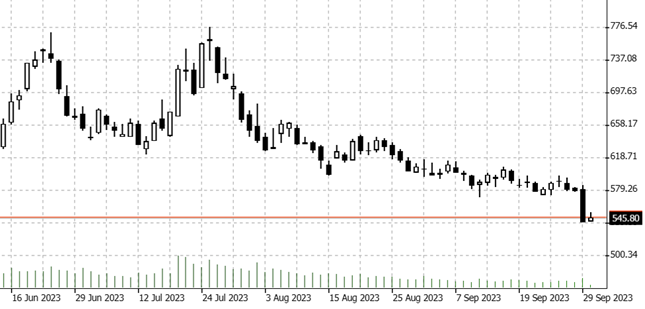

02.10.2023 – There is no all-clear for the bulls in the wheat market: the current slump is the strongest since the financial crisis in 2008 – for the fourth quarter in a row the market went downhill. The main reason is Russia. And the Midwest in the USA has defied the drought.
In the past three months, the price of wheat has fallen by around 11 percent, according to the financial blog “ZeroHedge”. Since the beginning of 2022, the price has more than halved, but here is the daily chart. Michael Whitehead, head of agribusiness at ANZ Group Holdings, said: “This may be the new, low price level for wheat.” Friday’s crop report from the US was responsible for the latest crash.

Source: Bernstein Bank GmbH
The US Department of Agriculture said the harvest in the 2023/24 marketing year was better than expected. For example, the USDA reported 1.812 billion bushels in its “Small Grains Summary” – the government forecast had been only 1.734 billion bushels. Analysts polled by Reuters had even expected only 1.729 billion bushels.
Strong harvest in Russia
News at the other end of the world also put pressure on prices. Farmers in the Russian Federation are about to harvest a record wheat crop – Russia is one of the world’s dominant exporters. “We have seen wheat prices substantially decline basically as a result of Russia,” Michael Magdovitz, senior commodity analyst at Rabobank, told Bloomberg. About a fortnight ago, Fastmarkets reported that Russia was heading for its second-biggest harvest ever, probably 90 million tonnes.
The bears are loose
No wonder that the market is predominantly sceptically positioned: the commodity broker Blue Line Futures counted about 66,000 long positions against about 169,000 short contracts. Bullish factors are hardly discernible at the moment. Only an escalation of the Ukraine war is likely to reverse the trend: The Financial Times recently warned that Russia’s Black Sea ports handle around 70 per cent of wheat exports. And Morgan Stanley added that the El Nino weather phenomenon could trigger a new “inflation shock”. We are keeping an eye on the situation for you – and wish you successful trades and investments!
____________________________________________________________________________________________________________________________________________
The content of this publication is for general information purposes only. In this context, it is neither an individual investment recommendation or advice nor an offer to purchase or sell securities or other financial products. The content in question and all the information contained therein do not in any way replace individual investor- or investment-oriented advice. No reliable forecast or indication for the future is possible with respect to any presentation or information on the present or past performance of the relevant underlying assets. All information and data presented in this publication are based on reliable sources. However, Bernstein Bank does not guarantee that the information and data contained in this publication is up-to-date, correct and complete. Securities traded on the financial markets are subject to price fluctuations. A contract for difference (CFD) is also a financial instrument with leverage effect. Against this backdrop, CFD trading involves a high risk up to the point of total loss and may not be suitable for all investors. Therefore, make sure that you have fully understood all the correlating risks. If necessary, ask for independent advice. CFDs are complex instruments and are associated with the high risk of losing money quickly because of the leverage effect. 68% of retail investor accounts lose money trading CFD with this provider. You should consider whether you understand how CFD work and whether you can afford to take the high risk of losing your money.7
